Stellar Science and a New Story · 6:11pm Oct 30th, 2020
If there weren’t already enough reasons this year to write a story about apocalyptic visions of a world consumed by darkness, the award of the Nobel Prize in Physics to Roger Penrose, Reinhard Genzel, and Andrea Ghez gave me the excuse to write something about black holes. It took me a few weeks to finish it, but I am pleased to have got it done ready for Nightmare Night.
There are actually three astrophysics stories woven into this:
The Fate of the Sun
Our sun is around 4.6 billion years old. All human history is just a blink in its lifetime. It is a huge ball of hydrogen, crushed by its own weight until it ignited nuclear fusion, forcing protons together to form helium, and releasing the mass difference as energy. It is now in a nice stable equilibrium, where the pressure of the energy pushing out balances its gravity pulling it in. Fortunately for us, it will stay in this well-behaved state for another few billion years.
Eventually it will start to run out of hydrogen fuel. Once the core becomes helium, the hydrogen will continue to fuse in a shell around it. The sun will swell to a red giant, become unstable, and quite probably consume the Earth in the process.
The core will collapse to a white dwarf and, at some point, the weight will make it hot it enough to start helium fusion. As it is so dense, this ‘helium flash’ happens very quickly as the helium turns to carbon and oxygen. The outer layers will then drift out into space as a planetary nebula. The remaining white dwarf will slowly cool down over a few billion years. A graceful end to a long life.
Life is rather different for heavier stars, which burn fast, die young, explode as supernovae, and end up as neutron stars or black holes. The full anthology includes many possible life stories.
Black Holes
The idea of the black hole is simple: an object with such a strong surface gravity that not even light can escape. Every massive object has an escape velocity—the speed you must reach to break free of its gravity. For the Earth, this is 11 kilometres per second. For the Sun, 615 kilometres per second, for a black hole, it is greater than light speed—300,000 kilometres per second.
If you want to make a black hole, you need to make something really dense, packing the mass of the sun in a sphere of radius less than 3 kilometres. This requires some patience. First, let a huge cloud of hydrogen gas collapse under gravity under it ignites nuclear fusion, then wait until your star has burned out. The resulting white dwarf will collapse to the point where it is just held up by the degeneracy pressure—the inability to force electrons closer together. But, if its mass exceeds the Chandrasekhar limit, about 1.4 times the mass of the sun, then it can collapse further and form a neutron star, where the protons and electrons are forced together and the star turns into an ultra-dense nucleus made entirely from neutrons, maybe 20 kilometres across. If heavy enough, it can then pass the point of no return and become a black hole.
The limit is named after the Indian physicist Subrahmanyan Chandrasekhar, who first worked out how to solve the equations in 1930, while on a ship to England to take up his degree at Cambridge University, where he then had to endure hostility from the great astrophysicist Sir Arthur Eddington, who is reported to have said “There should be a law of Nature to prevent a star from behaving in this absurd way.”
To theoretical astrophysicists, speculating about what could happen inside a black hole is very exciting, and has led to some really fascinating theories and fairy tales. This includes the work of Roger Penrose, who received the Nobel Prize in Physics 2020 "for the discovery that black hole formation is a robust prediction of the general theory of relativity." In other words, for showing that Eddington was wrong, and there is nothing to stop a star being absurd.
When I was taught stellar physics, twenty years ago, our lecturer only mentioned the Black Hole in the last lecture of the course and said that was the end of the story. Once a star became a black hole, it was of no further interest to observation astronomers as you can’t see it. However since then, observational astronomers have changed their minds and are now very much interested. The prize also went to Reinhard Genzel and Andrea Ghez, who showed there is a supermassive black hole at the centre of the Milky Way by tracking the paths of stars orbiting it. And last year we had the exciting news of the first image of a black hole.

EHT image of the black hole at the Messier 87 galaxy
Supernovae Type 1a
The final twist in the story is about supernovae. A star that goes supernova becomes as a bright as an entire galaxy for a few weeks. The last supernova in the Milky Way, visible to the naked eye, was in 1604, but they are routinely seen in distance galaxies using big telescopes.
Supernovae are complicated things and there are several different types. Some happen when a very massive star has exhausted all nuclear fuel and the iron core collapses. The supernova in our story is a Type 1a. This happens when a white dwarf, like the one our sun will become, draws matter off a companion star until its mass goes above the Chandrasekhar limit. It will then begin to collapse, but it doesn’t become a neutron star because as it heats up, it reignites nuclear fusion. As the nuclei are packed so close together, it all detonates in a flash and the star explodes.
This won’t happen to the sun as it doesn’t have a companion star, unless in some very improbable scenario a rogue star arrives in the solar system in the next few billion years.
A useful feature of type 1a supernovae is that they are standard candles. As they all explode at the same critical point, we can calculate how bright they are, and so their apparent brightness, measured at our observatory on Earth, tells us how far away they are. This makes them very useful for mapping the distances to galaxies far away.
That was a fun story to write, and it managed to pack in quite a lot of science. I hope you enjoyed the read. As usual, I want some data about how well this science communication project works, so please complete this reader questionnaire: https://forms.gle/AFvqCauBCMk8vfxY7







One thing I never seen discussed in articles about black holes is the composition of the physical star itself. Is it still a mass of neutrons, or do they compact into a cloud of quarks, or is the question meaningless because there's no time in which to transform into another state?
Also, what would a neutron star which is just a teeny bit* above the Chandrasekhar limit look like? How could we differentiate it from a black hole, since (I think) the light escaping it would be so ridiculously red-shifted that might be undetectable?
--------------
* Standard metric teeny, of course.
Thank you for shedding some light on this.. um... You know what I mean.
5388885
I think the reason it isn't discussed is because nobody knows for sure. But it is assumed that once the neutron degeneracy pressure is exceeded, it collapses into some sort of quark matter. The neutron stars we can see are pulsars - they spin very fast, and the radiation they emit is focussed in beams by the magnetic field, which sweep round and round. But I don't think it is possible to tell the difference between a black hole and a very dim neutron star.
5388911
Thanks!
Wasnt there something recently about the simulation of light around a neutron star, and they showed at a given mass, you could see the Entire surface at the same time from a single viewpoint, because the light diametrically opposite bent right round towards you? Beyond this point, light would just spiral round and round more times, forming rings of visible surface, like Newtons rings, squeezing and narrowing until they merged, forming a shell of light at the event horizon, the mass inside dissapearing from view totally?
Then again, I like the idea that blackholes dont make sense because we are trying to squeeze them into what we demand to be our flatland universe. Flat Torii are so much fun in appearence.
As for the world still being here in a few billion years, at the very least, cant we set up a gravity conveyor from jupiter to use the moon as a tractor?
5388973
I believe this is the literal definition of "singularity", of which black holes are one of the more well-known examples. And I have at least one physicist here to correct or confirm.
5388982
The weirdest, to our viewpoint, is the hyperbolic gemoetry idea of a blackhole. The event horizon is the inside of the throat at the narrowest point, the singularity is a mathematical virtual torus, and gravity inverts meaning anything falling in gets squeezed to the open center and comes out the other side like a rocket engine, a high ower narrow jet.
Of course, the throat is a 3D cross section in a higher dimentional structure, but obviously we cant have that being in only the visible number of dimentions.
5388973
I don't know the details, but there have been some simulations done for films like Interstellar, adding the effects of general relativity into ray tracing software to figure out what you would actually see when looking when at these objects. See: https://www.newscientist.com/article/dn26966-interstellars-true-black-hole-too-confusing/
5388982
Indeed, the trouble with singularities is that at that point all known laws of physics break down, and we just have to admit that, whether by fault of the singularity, or fault of the universe, we have no idea what will happen.
Sorry that I am late but it has been a wild and crazy week here. I shall read the story and do the feedback.